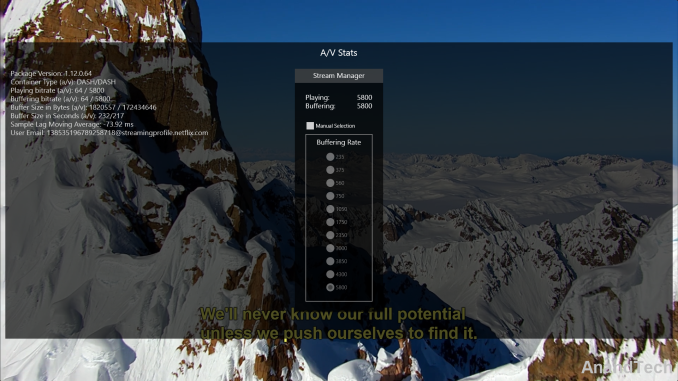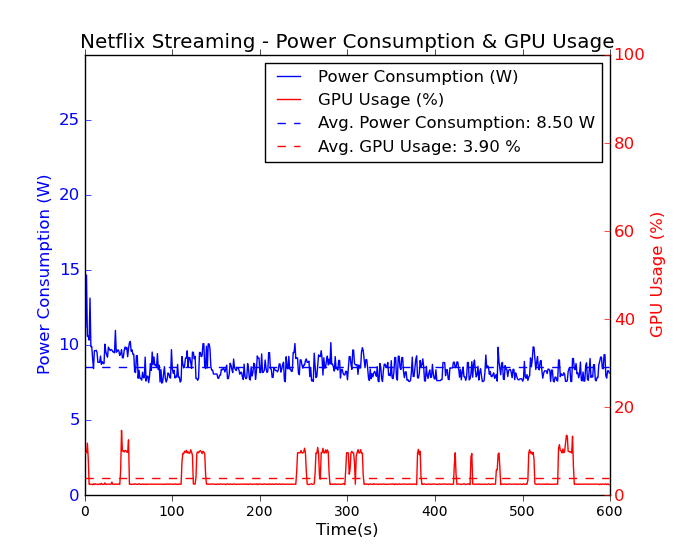Intel's Haswell NUC: D54250WYK UCFF PC Review
by Ganesh T S on January 3, 2014 4:25 PM ESTNetworking Performance and Streaming Aspects
In this section, we will take a look at the networking capabilities of the unit and also our standard HTPC streaming tests (involving YouTube and Netflix). Starting with this review, we are standardizing our evaluation of the wireless networking capabilities of UCFF and industrial PCs. Our standard test router is the Netgear R7000 Nighthawk configured with both 2.4 GHz and 5 GHz networks. The router is placed approximately 20 ft. away, separated by a drywall (as in typical US buildings). A wired client (Zotac ID89-Plus) is connected to the R7000 and serves as one endpoint for jPerf evaluation. The UCFF PC is made to connect to the two wireless SSIDs and jPerf tests are conducted for both TCP and UDP transfers with pre-set transfer parameters.
In our NUC build, Intel's Dual-Band Wireless-7260 delivers 2T2R 802.11ac speeds and provides very good throughput numbers when used with an appropriate router. As the gallery below shows, the 2.4 GHz band is able to deliver TCP throughput in the region of 86 Mbps and UDP throughput in the region of 96 Mbps.
The theoretical bandwidth number for 2x2 802.11ac is 867 Mbps. Practically, in the 5 GHz band, the 7260's TCP throughput is around 210 Mbps and UDP throughput is around 239 Mbps in our test setup.
Network Streaming Performance - Netflix and YouTube
YouTube and Netflix are two very popular streaming services utilized on HTPCs. With Windows 8, Silverlight is no longer necessary for Netflix streaming. The Netflix app on Windows 8 supports high definition streams (up to 5.8 Mbps) as well as 5.1-channel Dolby Digital Plus audio on selected titles.
It is not immediately evident whether GPU acceleration is available or not from the OSD messages. However, GPU-Z reported an average GPU utilization of 4% throughout the time that the Netflix app was playing back video. The average power consumption was around 8.5 W. Coming it at less than 10 W for the whole system while streaming HD video is very impressive. The spikes in the GPU usage were observed whenever the subtitles or control OSD kicked in. There is obviously some correlation between these spikes and the recorder power consumption at the wall.
One of the issues that I faced with the Netflix app was that bitstreaming HD audio (Dolby Digital Plus) would just not work. The playback was jerky to the point of being unwatchable and with either no or intermittent audio output to the AV receiver. Apparently, this is an issue faced by multiple users, and the problem stems from the Intel Display Audio Driver. Intel's rep on the forums, however, has been unable to reproduce the issue. So, it looks like many users are being left high and dry, unable to take advantage of one of the most important aspects of running Netflix as a Metro app.
Unlike Silverlight, Adobe Flash continues to maintain some relevance right now. YouTube continues to use Adobe Flash to serve FLV (at SD resolutions) and MP4 (at both SD and HD resolutions) streams. YouTube's debug OSD indicates whether hardware acceleration is being used or not.
Despite Windows 8 having plenty of YouTube apps, the browser interface is pretty much functional and free of external intrusive ads. The graph below shows the power consumption and GPU loading when playing a YouTube video in full screen using the Adobe Flash plugin on Mozilla Firefox.
The average GPU load is pretty constant around 8%, but power consumption at the wall has spikes corresponding to bursts of network activity. These bursts die down towards the end, after the full video gets buffered.
We saw that Haswell provided great power benefits for such network streaming activities in our HTPC piece at launch time. The Intel NUC takes this power benefit one step further by using a ULV processor. With a power consumption of less than 10 W for these activities, we are approaching dedicated media streamers' territory with the added flexibility of a full-blown PC at one's disposal.




















107 Comments
View All Comments
chrnochime - Sunday, January 5, 2014 - link
Burned haha. Go ask this question on any english forum worth its salt and realize how wrong you are LOLandrusoid - Thursday, January 9, 2014 - link
Not a double negative. Read a book, preferably one concerning grammar and english usage. "So you actually agreeing with ddriver." Something's missing. By the way, "dis" is not negation. (This is not a double negative statement, as well.)theangryintern - Friday, January 10, 2014 - link
That sounds like a confession to me. In fact the double negative has led to proof positive. I'm afraid you gave yourself away.ddriver - Saturday, January 4, 2014 - link
You can be sorry and disagree all you want but this will not change the facts.That particular atom chip is a POC, slower than even mid-range contemporary phones, with terrible GPU (cripples browser rendering performance) and running a bloated OS. I have very smooth experience with both "desktop" websites (I hate crippled mobile versions) and with PDFs sporting high resolution images (here the reader implementation plays a tremendous role) on my phone (note 3) - that type of content is literally FLYING. I haven't been printing from the phone yet, but I am pretty sure it will not take minutes to print a 20 page document.
And don't think for a moment that I am used to sluggish performance and therefore have lower standards and expectations. My desktop config: i7 3770k 32gb samsung 830 SSD - while 2 years old, by no means a sloth.
BehindEnemyLines - Sunday, January 5, 2014 - link
It makes me wonder why Chrome OS laptops are moving from ARM to Intel x86 (Haswell) if it's "slower than even mid-range contemporary phones"? I mean, Chrome OS started with ARM, and it's pretty lightweight.Gigaplex - Sunday, January 5, 2014 - link
An old Atom is slow, not Haswell.lhl - Friday, January 17, 2014 - link
I have both the Samsung Series 3 (Exynos 5) Chromebook and the new Haswell-based C720. Performance difference/day-to-day usability is night and day, the C720 blows aways the ARM Chromebook. While I'd imagine TDP to be slightly higher, the C720 actually has much longer battery life (8h vs 5h) while only being 3-4 ounces heavier. The C720 also has better build-quality, screen, keyboard, and trackpad...JohanAnandtech - Sunday, January 5, 2014 - link
I guess I will have to benchmark it to prove it. You are downplaying the N2800, but it was close enough to a 1.4 GHz Quad Cortex A9 with a 2 MB L2 (Calxeda ECX-1000). That is very similar to the current midrange Phone. In fact, given how bandwidth bottlenecked most ARM CPUs are, the 4 MB L2 would probably give that chip an edge over the current midrange.virtual void - Sunday, January 5, 2014 - link
There is something about Intels CPU-design vs ARM that does not show in benchmarks like Geekbench and similar. Even the old Z2460 (single core "old" Atom) platform still feels quite snappy when running Android, the "feel" of this SoC is way better than what one would believe when looking purely at benchmarks.My guess is that Intels CPU-cache design, especially L2, still is a couple of notch above what any ARM CPU vendor current got.
shodanshok - Sunday, January 5, 2014 - link
I absolutely agree. In the past I tried to show that as benchmark results show, a single Atom Core is quite comparable to anything between one and two A9 cores. However, many poster simply choose to ignore this fact, accusing me to be totally wrong...